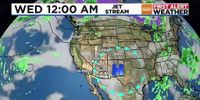Southern California and Arizona are in the grip of a persistent summer heatwave, with meteorologists warning that the sweltering conditions are set to linger through the coming week. As of August 9, 2025, a dome of high pressure that brought soaring temperatures to Southern California is beginning to ease, but not enough to offer immediate relief. Meanwhile, Arizona faces an extended Extreme Heat Warning, with no respite in sight until at least Tuesday evening.
According to KABC, the high-pressure system that fueled the recent warmup across Southern California is starting to move away. Yet, its influence remains strong enough to keep the region basking in above-average warmth over the weekend. "Temperatures will drop by a few degrees, but it will still be a warm weekend overall," the station reported. Residents hoping for a cool-down will have to wait a little longer, as an area of low pressure from the Gulf of Alaska is only expected to enter the forecast next week, promising to lower temperatures by mid-week.
For those living in Los Angeles and Orange counties, Saturday, August 9, brings a familiar pattern: morning fog that gives way to afternoon sunshine. The high is forecast to reach 87 degrees, with lows dipping to 62 degrees overnight. The upper 80s will likely persist through much of the upcoming week, offering little relief for those sensitive to heat.
Inland, the situation is even more intense. The valleys and Inland Empire are set to experience a high of 96 degrees and a low of 65 on Saturday. While a slight decrease is anticipated, with highs dropping to the low 90s by Monday, August 11, the heat remains a constant companion for residents and visitors alike.
Coastal communities fare somewhat better, though not by much. Beaches on Saturday can expect the same morning fog and afternoon sunshine as the rest of the region, with highs peaking at 76 degrees and lows at 65. The mountains offer a modest escape, with highs of 86 and lows of 53, but even these elevations are not immune to the broader warming trend.
The deserts, however, are where the heat becomes truly punishing. On Saturday, highs are forecast to reach 105 degrees, with lows at 70. Palm Springs, in particular, is expected to sizzle at 114 degrees, and triple-digit heat is projected to stick around for most of the coming week. In a region where summer heat is nothing new, these numbers still stand out for their intensity and duration.
As the mercury climbs, local authorities and weather services are urging residents to take precautions. The Free ABC7 Los Angeles app and Accuweather app are being promoted for real-time weather alerts, and residents are encouraged to share their weather experiences using the hashtag #ABC7Eyewitness. These digital tools are more than just conveniences—they're lifelines for those needing up-to-date information on changing conditions, watches, and warnings.
But it's not just California feeling the heat. Across the border in Arizona, the situation is even more severe. According to the latest updates from Arizona meteorologists, the Extreme Heat Warning has been extended past the weekend, now stretching through Tuesday evening, August 12. "The latest models have trended warmer, with highs around 110-112 through the weekend and into Monday and Tuesday," reported Paul Horton during his 7 a.m. forecast on August 9. This extension means that millions of Arizonans will face dangerous heat for several days longer than initially anticipated.
First Alert Days have been declared across much of Arizona, reflecting the seriousness of the situation. The National Weather Service has repeatedly emphasized the risks associated with prolonged exposure to such extreme temperatures. Heat-related illnesses can develop quickly, especially for vulnerable populations such as the elderly, children, and those with pre-existing health conditions. Local officials are urging everyone to stay hydrated, avoid outdoor activities during peak heat hours, and check on neighbors who may need assistance.
For many in Arizona, the summer of 2025 has already been one for the record books. The persistence of triple-digit highs, coupled with the extension of the Extreme Heat Warning, has tested the resilience of communities and the preparedness of local infrastructure. Air conditioning units are working overtime, and concerns about energy demand and potential outages are never far from residents' minds.
Looking ahead, the forecast offers a glimmer of hope. In Southern California, the anticipated arrival of an area of low pressure from the Gulf of Alaska by mid-week could finally bring some relief, dropping temperatures to more manageable levels. But for now, the message from meteorologists is clear: the heat is here to stay, at least for a few more days.
It's not just about comfort—it's about safety. Prolonged heat waves can have serious consequences, from heat exhaustion and dehydration to more severe outcomes like heatstroke. Public health officials are reminding residents to pay close attention to their bodies, seek air-conditioned spaces whenever possible, and never leave children or pets in parked vehicles. As always, community support and vigilance can make a difference during such challenging times.
For those hoping to escape the heat, options are limited. Even the mountains, typically a refuge during summer, are seeing higher-than-average temperatures. Beaches offer some respite, but with highs in the mid-70s and crowds flocking to the coast, finding a cool spot can be a challenge. The best defense, experts say, is preparation: stay informed, stay hydrated, and stay indoors during the hottest parts of the day.
While the current heat wave is not unprecedented for the Southwest, its persistence and intensity serve as a stark reminder of the region's vulnerability to extreme weather. As climate patterns shift and high-pressure systems become more entrenched, such events may become more common in the years ahead. For now, Southern California and Arizona residents are doing what they do best—adapting, enduring, and waiting for the welcome relief that only cooler weather can bring.
With the promise of lower temperatures on the horizon, the coming week will test both patience and resilience. Until then, the sun continues to blaze, and the Southwest remains firmly in the grip of summer's relentless heat.




